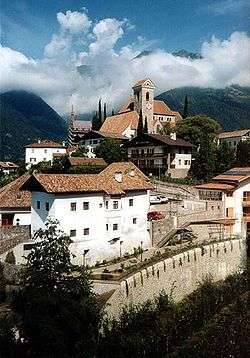Schenna
| Schenna | |
|---|---|
| Comune | |
| Gemeinde Schenna Comune di Scena | |
|
A panorama of Schenna | |
 Schenna Location of Schenna in Italy | |
| Coordinates: 46°41′N 11°11′E / 46.683°N 11.183°ECoordinates: 46°41′N 11°11′E / 46.683°N 11.183°E | |
| Country | Italy |
| Region | Trentino-Alto Adige/Südtirol |
| Province / Metropolitan city | South Tyrol (BZ) |
| Frazioni | Schennaberg (Montescena), Tall (Valle), Verdins |
| Government | |
| • Mayor | Alois Kröll |
| Area | |
| • Total | 48.2 km2 (18.6 sq mi) |
| Elevation | 600 m (2,000 ft) |
| Population (Nov. 2010) | |
| • Total | 2,841 |
| • Density | 59/km2 (150/sq mi) |
| Demonym(s) |
German: Schennaner Italian: di Scena |
| Time zone | CET (UTC+1) |
| • Summer (DST) | CEST (UTC+2) |
| Postal code | 39017 |
| Dialing code | 0473 |
| Website | Official website |
Schenna (German pronunciation: [ˈʃɛna]; Italian: Scena [ˈʃɛːna]) is a comune (municipality) in South Tyrol in northern Italy, located about 25 kilometres (16 mi) northwest of the city of Bolzano.
Geography
As of 30 November 2010, it had a population of 2,841 and an area of 48.2 square kilometres (18.6 sq mi).[1]
Schenna borders the following municipalities: Hafling, Kuens, Merano, Riffian, St. Leonhard in Passeier, Sarntal, and Tirol.
Frazioni
The municipality contains the frazioni (subdivisions, mainly villages and hamlets) Schennaberg (Montescena), Tall (Valle), and Verdins.
History
Origin
In the Middle Ages an important castle was built. Archduke Johann of Austria acquired it in 1845. In the 1970s, 1980s and 1990s many festivals took place inside it, but now, for health and safety reasons (since there was no emergency exit) there are no more.
Inside the castle, known as "Schloss Schenna" Andreas Hofer's cot is to be found.
Place-name
"Schenna" comes from the German "Schön Au" meaning "Lovely Pasture" which is why it used to be written "Schönna", although others say that it is named after a Roman landowner called Sconius. In the 6th-7th century people began to arrive from Bavaria and Franconia.
Coat-of-arms
The shield is argent and sable party per fess; at the top a gules lion is represented coming out from the bottom. The emblem was adopted in 1972, even if it was in use prior to World War I.[2]
Society
Linguistic distribution
According to the 2011 census, 98.18% of the population speak German, 1.67% Italian and 0.15% Ladin as first language.[3]
Demographic evolution

References
- ↑ All demographics and other statistics: Italian statistical institute Istat.
- ↑ Heraldry of the World: Schenna
- ↑ "Volkszählung 2011/Censimento della popolazione 2011". astat info. Provincial Statistics Institute of the Autonomous Province of South Tyrol (38): 6–7. June 2012. Retrieved 2012-06-14.
External links
- (German) (Italian) Homepage of the municipality
![]() Media related to Schenna at Wikimedia Commons
Media related to Schenna at Wikimedia Commons

